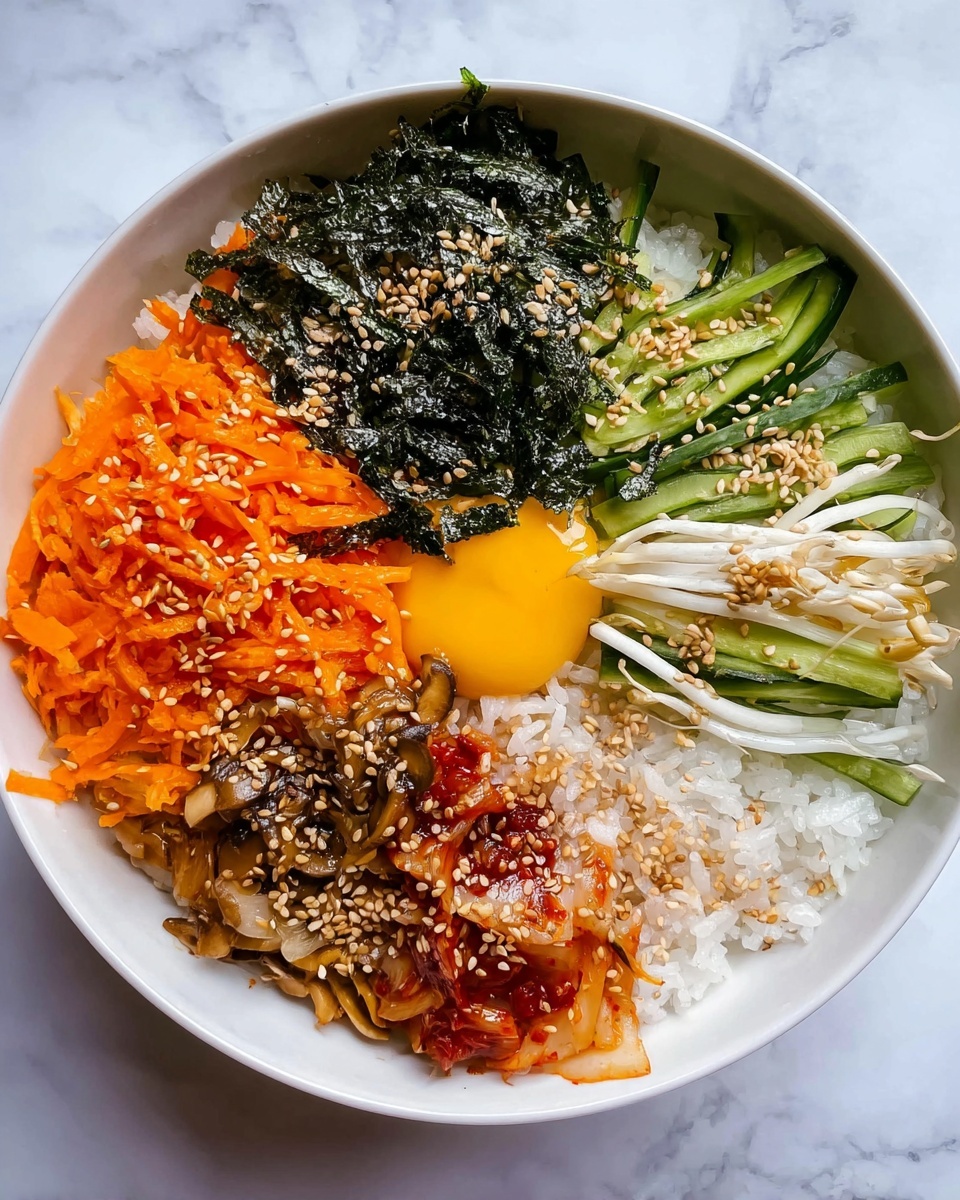If you’ve ever wanted to dive into Korean cuisine but worried about complicated ingredients or lengthy prep, this Simple Vegetarian Bibimbap Recipe is your perfect gateway. Bursting with vibrant vegetables, aromatic sesame, and the spicy kick of gochujang, it delivers a satisfying, colorful meal that’s as fun to eat as it is to make. Whether you’re a seasoned veggie lover or just exploring plant-based dishes, this bowl is a harmonious blend of textures and flavors that comes together effortlessly, making it a fast favorite for any day of the week.

Ingredients You’ll Need
The magic of this dish lies in its simplicity and balance—each ingredient plays a precise role in crafting the perfect bite. These easy-to-find staples bring bright colors, diverse textures, and rich flavors that make the bibimbap both nutritious and delightful.
- Short-Grain Rice: The base of bibimbap, providing a sticky, chewy texture perfect for mixing with vegetables and sauce.
- Carrot: Adds a crisp, slightly sweet crunch and a lovely vibrant orange color.
- Zucchini: Softens nicely when sautéed and adds a mild freshness to the bowl.
- Fresh Spinach: Blanched to tender perfection, it offers deep green color and earthy flavor.
- Mushrooms: Sautéed until golden, they bring an umami richness and meaty texture.
- Gochujang (Korean chili paste): The hallmark spicy and slightly sweet flavor that gives bibimbap its signature kick.
- Sesame Oil: Provides toasty, nutty depth that ties all ingredients together beautifully.
- Green Onions: Sprinkle on top for a fresh, sharp bite that brightens the dish.
- Kimchi: Optional but recommended, it adds tangy crunch and probiotics to amplify the meal’s dimension.
- Toasted Sesame Seeds: The finishing touch that adds a subtle crunch and a toasty aroma.
How to Make Simple Vegetarian Bibimbap Recipe
Step 1: Cooking the Rice
Start by rinsing 1 cup of short-grain rice in cold water until the water runs clear to remove excess starch. Cook the rice according to your preferred method—using a rice cooker or stovetop works great. Once cooked, let it rest covered for 10 minutes; this ensures each grain is perfectly tender and slightly sticky, setting a solid foundation for the bowl.
Step 2: Prepping the Vegetables
While the rice is cooking, prepare your veggies: julienne the carrot for a nice crisp bite, slice the zucchini into thin strips so they cook evenly, and slice the mushrooms thinly. These preparations ensure that each vegetable has the perfect texture and blends beautifully together once cooked.
Step 3: Sauté Mushrooms
Heat a splash of vegetable oil in a skillet over medium-high heat. Add the sliced mushrooms and cook for about 4 to 5 minutes, stirring occasionally until they turn a gorgeous golden brown and release their rich, earthy flavor. This step adds a savory umami element that complements the fresh veggies wonderfully.
Step 4: Cook Carrots with Mushrooms
Next, toss the julienned carrots into the skillet with the mushrooms and sauté for about 2 to 3 minutes. You’re looking for the carrots to soften slightly but still retain a fresh crunch that adds exciting texture contrast to the dish.
Step 5: Add Zucchini
Introduce the zucchini to the pan and continue sautéing everything together for another 3 to 4 minutes. The zucchini becomes tender and slightly sweet, perfectly balancing the earthiness of the mushrooms and the crispness of the carrots.
Step 6: Blanch the Spinach
Bring a pot of water to a boil and blanch 2 cups of fresh spinach quickly for 1 to 2 minutes until just wilted. Immediately transfer the spinach to an ice bath to keep its vibrant green color and stop the cooking process. Drain well before adding to your bibimbap to keep it light and fresh.
Step 7: Assemble the Bowl
Ready your bowls by scooping the cooked rice first and then artfully arranging the sautéed mushrooms, carrots, zucchini, and blanched spinach on top. This colorful presentation makes the meal inviting and visually appealing, perfect for sharing.
Step 8: Add Sauce and Garnishes
Whisk together 2 tablespoons of gochujang with 1 tablespoon of sesame oil to create a luscious, spicy sauce. Drizzle this over the arranged vegetables to infuse the bowl with classic Korean flavors. Sprinkle chopped green onions and toasted sesame seeds on top for freshness and crunch.
Step 9: Serving Warm and Mixed
Serve your bibimbap immediately while everything is warm. Encourage everyone to mix their bowl thoroughly before eating, allowing the rice, vegetables, sauce, and garnishes to harmonize in every delicious bite.
How to Serve Simple Vegetarian Bibimbap Recipe

Garnishes
Simple garnishes like toasted sesame seeds and chopped green onions add a final layer of flavor and texture, elevating the dish from good to spectacular. A side of kimchi introduces zing and a refreshing crunch that cuts through the warmth of the sautéed vegetables.
Side Dishes
This vegetarian bibimbap pairs wonderfully with light, complementary sides such as miso soup or pickled radishes. These help balance the bold flavors and add contrasting textures, making the dining experience even more satisfying.
Creative Ways to Present
Feel free to serve the bibimbap in traditional Korean stone bowls (dolsot) to get a crispy rice crust, or try layering the ingredients inside lettuce cups for a fun, handheld twist. Both presentations bring an element of excitement and make each serving feel special.
Make Ahead and Storage
Storing Leftovers
Store any leftover bibimbap components separately in airtight containers to keep textures intact. Rice should be refrigerated within two hours of cooking and is best consumed within 3 to 4 days for optimal flavor and safety.
Freezing
While the rice and sautéed vegetables can be frozen, freezing fresh spinach is not recommended as it becomes watery upon thawing. Portion the elements you freeze appropriately so you can thaw just what you need for an easy meal later on.
Reheating
Reheat leftovers in a microwave or on the stovetop until warmed through. Adding a drizzle of sesame oil while reheating helps revive the flavors and moisture. Mix thoroughly before serving for the full bibimbap experience.
FAQs
Can I use other vegetables in this Simple Vegetarian Bibimbap Recipe?
Absolutely! Feel free to swap or add vegetables like bell peppers, bean sprouts, or cucumbers depending on your preference or seasonal availability. The key is to keep a nice balance of flavors and textures.
What if I don’t have gochujang?
If gochujang isn’t available, you can substitute with a mix of miso paste, chili powder, and a touch of honey or maple syrup to mimic the sweet-spicy flavor. Still delicious, though not quite the same.
Is this bibimbap recipe vegan friendly?
Yes! This Simple Vegetarian Bibimbap Recipe contains no animal products and is completely vegan. Just ensure your kimchi is vegan as some brands might use fish sauce.
How spicy is the dish?
The spiciness depends on the amount of gochujang you add. You can adjust it to your own heat tolerance—from mild and flavorful to fiery and bold.
Can I make this recipe gluten-free?
Definitely. Just check that your gochujang and soy sauce (if used) are gluten-free, and swap out any questionable ingredients accordingly. The rice and vegetables themselves are all naturally gluten-free.
Final Thoughts
This Simple Vegetarian Bibimbap Recipe is a fantastic way to enjoy a nutritious, colorful, and deeply satisfying meal that feels like a celebration in every bowl. It’s approachable for cooks of all levels and perfect for sharing with friends or family. I promise, once you try it, bibimbap will quickly become one of your favorite go-to dishes for a wholesome, homemade treat.
Print
Simple Vegetarian Bibimbap Recipe
- Prep Time: 15 minutes
- Cook Time: 30 minutes
- Total Time: 45 minutes
- Yield: 4 servings
- Category: Main Course
- Method: Stovetop
- Cuisine: Korean
- Diet: Vegetarian
Description
A simple and delicious vegetarian bibimbap recipe featuring seasoned sautéed vegetables, fresh spinach, and flavorful gochujang sauce served over warm short-grain rice. This Korean-inspired dish is vibrant, nutritious, and perfect for a wholesome meal.
Ingredients
Rice
- 1 cup Short-Grain Rice (Rinse until water runs clear)
Vegetables
- 1 medium Carrot (Julienned)
- 1 medium Zucchini (Sliced into thin strips)
- 2 cups Fresh Spinach (Blanched or sautéed)
- 1 cup Mushrooms (Sliced shiitake or button)
- 1 bunch Green Onions (Chopped)
Seasonings and Garnishes
- 2 tablespoons Gochujang (Korean chili paste)
- 1 tablespoon Sesame Oil (For flavor enhancement)
- Vegetable Oil (For sautéing, approximately 2 tablespoons)
- To taste Kimchi (For serving)
- To taste Toasted Sesame Seeds (Optional garnish)
Instructions
- Cook the Rice: Rinse the short-grain rice under cold water until the water runs clear. Cook the rice in a rice cooker or on the stovetop according to package instructions. Let it sit covered for 10 minutes after cooking to finish steaming.
- Prepare Vegetables: Julienne the carrot, slice the zucchini into thin strips, and slice the mushrooms.
- Sauté Mushrooms: Heat vegetable oil in a skillet over medium-high heat. Add the sliced mushrooms and sauté for 4-5 minutes until they are browned and tender.
- Sauté Carrots: Add the julienned carrots to the skillet with the mushrooms and sauté for 2-3 minutes until the carrots begin to soften. Stir to combine evenly.
- Sauté Zucchini: Add the sliced zucchini to the skillet and continue sautéing for an additional 3-4 minutes until the zucchini is tender.
- Blanch Spinach: Bring a pot of water to a boil and blanch the spinach for 1-2 minutes until wilted. Immediately transfer spinach to an ice bath to stop cooking, then drain thoroughly and set aside.
- Assemble Bibimbap: Place cooked rice in serving bowls. Arrange the sautéed mushrooms, carrots, zucchini, and blanched spinach on top of the rice, keeping the vegetables separated for a colorful presentation.
- Add Sauce and Garnish: Mix the gochujang with sesame oil and drizzle it evenly over the vegetables. Sprinkle chopped green onions and toasted sesame seeds on top as garnish.
- Serve: Serve the bibimbap immediately while warm, with kimchi on the side if desired. Encourage each person to mix their bowl well before eating to enjoy all the flavors together.
Notes
- If you prefer a gluten-free option, ensure that the gochujang used is gluten-free as some brands may contain wheat.
- You can substitute mushrooms with other vegetables like bell peppers or bean sprouts for variation.
- For extra protein, consider adding a fried egg on top or tofu alongside the vegetables.
- Adjust the amount of gochujang according to your spice preference.
- Using a rice cooker simplifies the rice preparation, but stovetop cooking works equally well.








